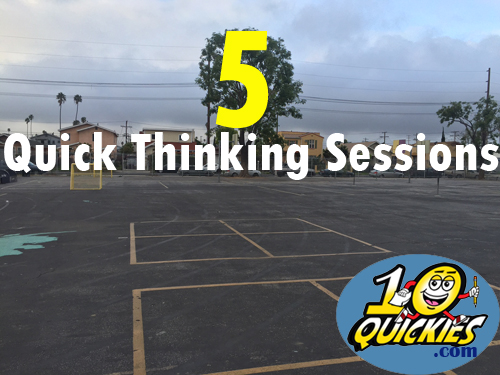Education Articles for Effective Teaching Practices
|
 |
  Five Quick Thinking Sessions Article Summary: Use these 5 quick thinking sessions you can use to get your students really thinking creatively and outside the box. Generate excitement and at the same time create a meaningful activity. ------ Five Quick Thinking Sessions by Gregory L. Gomez Here are five ways to get students utilizing various strategies with these quick thinking sessions. Students will sharpen their skills pondering the answers to these thought provoking questions. What is important the students keep in mind is that there is more than one correct answer to these questions. That is the beauty of these exercises. The students will have a greater freedom of expression without the fear of being wrong. 5 Quick Thinking Sessions99 Uses For... ============== Here is a fun way for students to think of realistic, non humorous uses for a specific object. The question is simply posed as "How many uses can you think of for a ...." Here's an example to get your wheels turning: What are 99 uses for a shoebox? Possible answers: hamster container, keep my collection of rocks, make a diorama, fill with dirt, to put my shoes in, baseball card container, to put all my stickers in, etc. You can literally think of hundreds of different regular items to have students come up with alternate uses. A cup, blanket, a paperclip, pencil, book, and the list goes on and on. You can even have the students come up with their own item to pose to the class or in small partner groups. Fact or Opinion? =============== Here is an easy and fun way to review the difference between fact and opinion with your students. Before you have them work on their own, it's best to reiterate the difference between the two. Simply prepare a short list of fact and opinion statements and ask the class for their answer. And so you don't get 30 students yelling "fact" or "opinion" back at you, have them write a large F on one side of a piece of paper, and a large O on the other. They can then silently hold up the answer of their choice when prompted to do so. You can tell them to hold the paper sideways if they are unsure of the answer too. Or to make the activity more kinesthetic, you can have the students stand up for Fact, and remain in their seats for Opinion. Both thumbs sideways for unsure. Or whatever else you decide to represent these answer choices. Once they have an opportunity to answer your list of fact and opinion statements, they can start creating their own list. You can call a couple students to the front of the room and have the class answer their statements, or have students work in small groups or with partners and where they each get a turn to read their list. Here's the Answer, What's the Question? ================================ This is an entertaining way to get interesting thoughts from your students. The way this works is you give the students an answer, and they generate the questions that would be true, and fit. For example, Answer: Outside. Possible Questions: Where do you find a tree? Where do birds fly? Where does it rain? At recess, where do you play? Here's another example. Answer: The Lakers. Question: What basketball team plays at the Staples Center? What team is Kobe Bryant on? What NBA team has purple and gold uniform colors? What professional basketball team moved from Minneapolis, Minnesota to Los Angeles, California? Again, guided whole group instruction first so they class grasps the concept, then partner pair/small group work opportunities as you see fit. How is _______ like a ________? =============================== This quick thinking session is great especially for students to think of analogies, similarities and differences. To start off, do a couple whole group examples first so students understand the objective. How is a flower like a tree? They are both planted in the ground. They both need sunlight and water to grow. They both develop a root system. To increase the difficulty level, think of more difficult comparisons such as, how is a child like a flower? (both need water to survive, both grow, both form roots when young, both have a main stem/trunk, etc.) Or how is a car like a television? (both have buttons to push, both use electronics, both have lights, both built with metal parts, etc.) There Isn't One Correct Answer ============================== Students will have to think of logical responses to these statements. Again stress the fact that there isn't one correct answer but many possibilities. - Why did the teacher yell "Stop!" to the students? Possible answers: because the class was talking too loudly, because someone was tapping their pencil on their desk, because they were playing red light, green light, etc. - What are some different sounds you can recognize without seeing what made the noise? Answer Possibilities: A fire truck, a car alarm, school bell, ring tone, dog bark, a whistle, etc. - "There must be a fire over there in that building!" yelled Mark. What might have caused mark to say that? Answer Possibilities: Smoke was rising from the building, fire trucks were parked in front, people were screaming for help, etc. - Don't forget to take these with you." said Alejandra as Greg left for the beach. What could Alejandra have reminded Greg not to forget? Answer Possibilities: beach towels, sunscreen, boogie board, surf board, umbrella, etc.. Conclusion ======== As you can tell, these thought provoking questions without one absolute correct answer have great potential to get students really thinking about possibilities. Use these quick thinking sessions to generate creativity and induce voluntary enthusiasm. You will find some students really trying to get creative with the answers they are able to come up with too, wanting to be the one who surprises you most with their thoughtfulness. --- Gregory L. Gomez, M. Ed, has been teaching 5th grade in the Los Angeles Unified School District for 16 years. He created 10Quickies.com to help teachers and parents provide children in grades 2-5 with a fun and inspirational way to review math standards and concepts. Get valuable teaching strategies along with 4 FREE math worksheets to download just for stopping by. We hope you found this article informative and that you'll be able to take some of the ideas and incorporate them into your classroom. We invite you to take a moment to download four FREE math review worksheets that students have found to be fun and exciting. These aren't the typical worksheets that you've seen before, so don't be surprised if you find your students begging for more 10 QUICKIES! |


